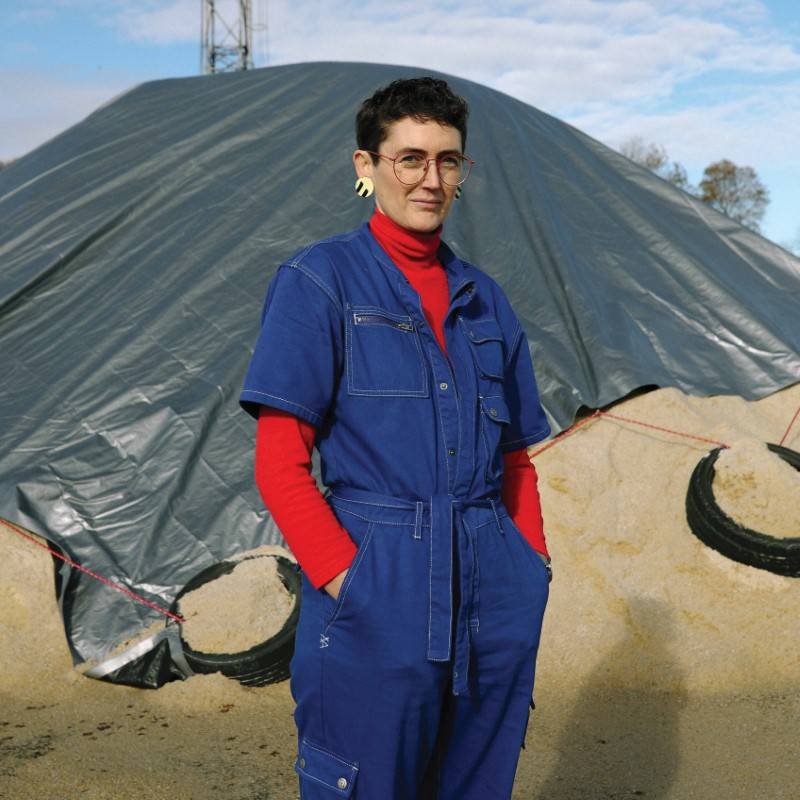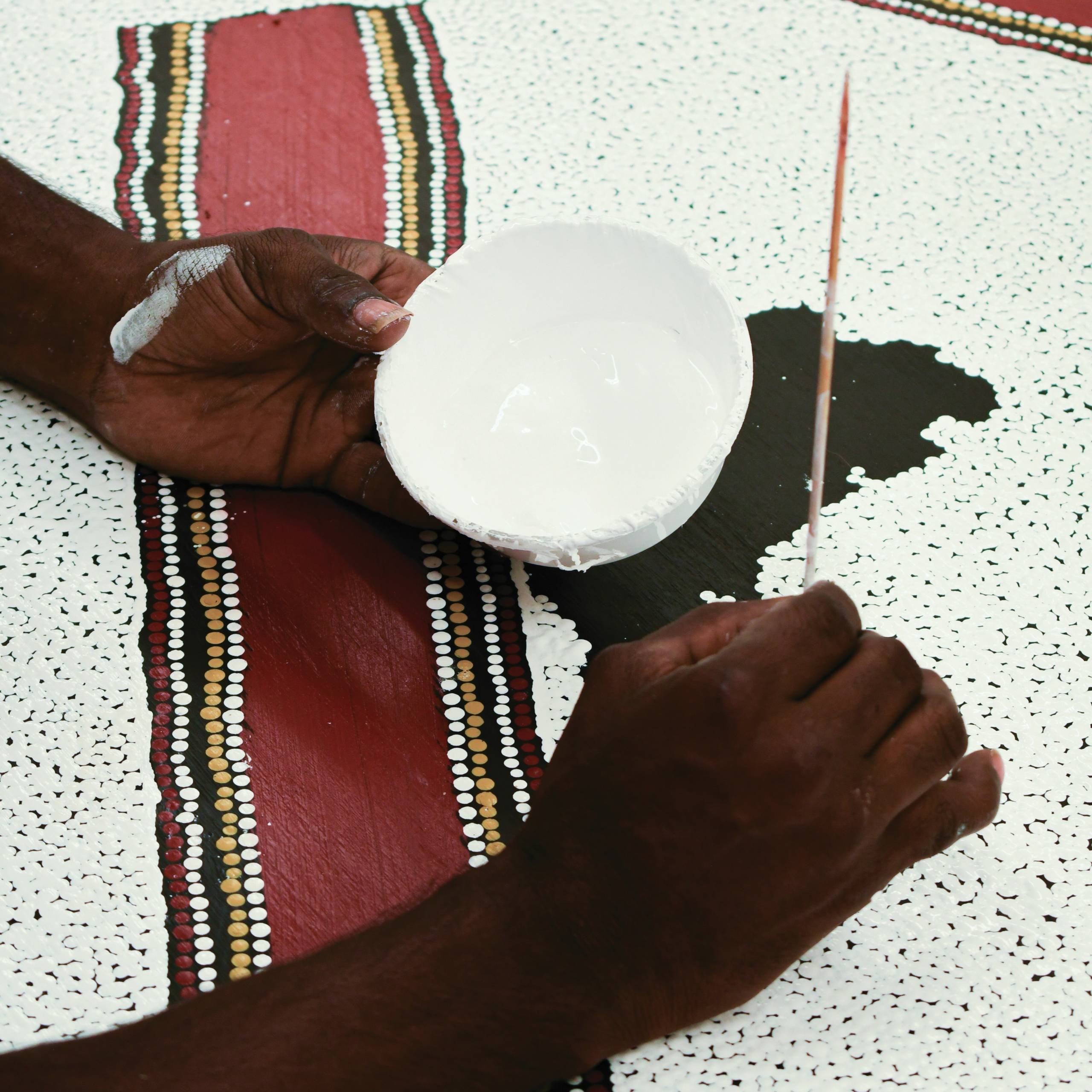Conor Clarke: Collapsing Into Reality
The photographs of Conor Clarke consider the relationship between unspoiled natural landscapes and the colonial gaze.
Words: Lachlan Taylor
Photography: Naomi Haussmann
One way of understanding Conor Clarke’s landscape photographs is to think of them like mirages. As if they function a little like stage magic – appearing as one thing and then, in a moment of correction, revealing themselves as something else entirely. Bustling smokestacks that look like fluffy clouds, piles of dirt presenting as mountains. The point of the mirage is the moment of realisation, where it stops being an illusion and becomes material, where fantasy collapses into reality.
Take an image like Angle of Repose, 2016, which looks on its face like an almost Olympian mountainscape. A band of trees bounds the bottom of the image, a thick overcast sky the top. A mountain ridge crosses the centre in a familiar form but discordant colour. The soil isn’t quite right, appearing an almost luminous grey. In the top-right corner, the far edge of some industrial machinery ventures into the photograph, dumping material onto the mountaintop. It’s just that small invading element that gives up what the photograph really shows: masses of sodium chloride, spoil heaps from potash mining in the region of Germany where Clarke took the photo. The snap of revelation breaks the mirage. A sublime fantasy of beautiful mountains exposes itself as the unwanted material excess of heavy industry. The power of images like Angle of Repose is Clarke’s ability to entangle ways of seeing with ways of living – complicating the engrained desire to separate a love of natural beauty with the realities of living in extractive societies.
This function of Clarke’s work has remained a part of her practice as it’s developed over recent years. But it has been joined by other actions and impulses that have augmented and transformed what exactly her photography does, and how we might read and understand it.
Work made in Europe and Aotearoa has explored how the desire to look at unspoiled and untouched nature was and remains connected to the colonial gaze – fused to its need to take, own, and organise the land it touches. Clarke makes the camera itself a conspirator in that gaze, a machine used to enact its desires. And in this way, the mirage has become more like a mirror, turning the gaze back at the one making it.
Recently, Clarke has added further aspects of reciprocity and personal history into her images. Instead of a mirage, something like an accordion or concertina seems a more appropriate model. The photographs stretch and collapse, closing the distance between viewer and subject while keeping open the option to pull it all back out again. Mind map, 2021 was taken in a church on Clarke’s marae near Kaikōura. The sawdust spilled by borer beetles has left another set of mountain ridges. This time, there’s no illusion that these mountains might be the real thing, but they create echoes in other ways. Out past the marae rise the ridges of the Kaikōura Ranges, and within them Clarke’s ancestral mountain. The immediate image reflects its unseen referent, and the mountains beyond connect back to the place of the image. She softly upsets the distance between what feels close and what seems far away, while never pretending to collapse it entirely.
Clarke is represented by Two Rooms Gallery, Auckland and Jonathan Smart Gallery, Christchurch.
JONATHAN SMART
Director, Jonathan Smart Gallery, Christchurch
“I’ve represented Conor Clarke for only a couple of years, and this will be her first solo project with the gallery – which is very exciting. She has worked and shown in Berlin before returning home 4 years ago; and in that time she enjoyed a breakout presence in a group show, curated by Melanie Oliver at Christchurch Art Gallery/Te Puna O Waiwhetū – a series of photographs that overlaid images with braille and sound – the latter being text read by partially sighted volunteers describing their sensory experience of the subject photographed.
I’m drawn not only to the visual qualities of Conor’s work but also the emotional integrity with which she works – there is a warmth, a certain emotional pitch at the core of what she does – and that sense of community and of belonging is quietly growing as she works now in Te Wāhipounamu, close to her Ngāi Tahu roots.
Angle of Repose is Clarke’s MFA show, completed whilst teaching at Ilam School of Fine Arts, University of Canterbury. It promises to be one of the highlights of the Gallery program for 2023.”
MELANIE OLIVER
Curator, Christchurch Art Gallery Te Puna O Waiwhetū
“I first saw Conor’s work on her website and was intrigued, so invited Conor to make a new body of work for the Christchurch Art Gallery Te Puna o Waiwhetū. This led to her beginning the series As far as the eye can reach that Conor made with the Blind Low Vision community. I love this project and how she invites us to consider other ways of describing what we see, using all of our senses.
Conor’s work is underpinned by rigorous thinking, delivered gently, resulting in images that are always beautiful and sometimes reveal their importance gradually. Each has a narrative that looks at our complex relationship to place, how we view and represent the world around us. She takes simple moments and gives them a new slant, often challenging our assumptions, in at times witty ways. She makes us question what we see and why we believe an image, playing with things like scale and framing.
Conor has not only a love for photography, but a broad knowledge of the history of how photographs have been made and the contexts they can circulate in. For example, she thinks about the relationship of the photographer to the subject and the community the images are meant for, and brings an understanding of how photographs might play different roles.”
This article was originally published in Art Collector issue 105, July-September 2023.









